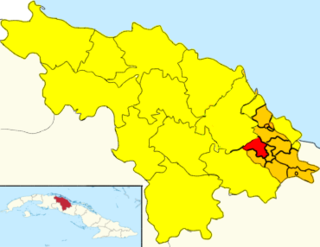Related Research Articles

The Sandinista National Liberation Front is a socialist political party in Nicaragua. Its members are called Sandinistas in both English and Spanish. The party is named after Augusto César Sandino, who led the Nicaraguan resistance against the United States occupation of Nicaragua in the 1930s.

Managua is the capital and largest city of Nicaragua, and one of the largest cities in Central America. Located on the shores of Lake Managua, the city had an estimated population of 1,055,247 as of 2020, and a population of 1,401,687 in its metropolitan area. The city also serves as the seat of Managua Department.

Augusto C. Sandino, full name Augusto Nicolás Calderón de Sandino y José de María Sandino, was a Nicaraguan revolutionary and leader of a rebellion between 1927 and 1933 against the United States occupation of Nicaragua. Despite being referred to as a "bandit" by the United States government, his exploits made him a hero throughout much of Latin America, where he became a symbol of resistance to American imperialism. Sandino drew units of the United States Marine Corps into an undeclared guerrilla war. The United States troops withdrew from the country in 1933 after overseeing the election and inauguration of President Juan Bautista Sacasa, who had returned from exile.

Jinotega is a department of Nicaragua. Its departmental head is Jinotega. It is located in the north of the country, on the border with Honduras.

Catalina Sandino Moreno is a Colombian actress. She shared the Silver Bear with Charlize Theron and received a nomination for the Academy Award for Best Actress for her leading role in Maria Full of Grace (2004). As of 2023, she stars as Tabitha Matthews in the Epix television series From.

The Carretera Central (CC), meaning "Central Road", is a west-east highway spanning the length of the island of Cuba.

Santa Clara is the capital city of the Cuban province of Villa Clara. It is centrally located in the province and Cuba. Santa Clara is the fifth-most populous Cuban city, with a population of nearly 250,000.

Matilde Zimmermann is an American author and professor who ran as the Socialist Workers Party candidate for United States Vice President in 1980. The party had three different presidential candidates that year, Andrew Pulley, Richard H. Congress and Clifton DeBerry depending on the state. She was at the time a writer for the party newspaper The Militant. Zimmermann also ran as an alternate vice presidential candidate for Andrea Gonzales in some states in 1984; Melvin T. Mason was the presidential candidate.
Sandinista ideology or Sandinismo is a series of political and economic philosophies instituted by the Nicaraguan Sandinista National Liberation Front throughout the late twentieth century. The ideology and movement acquired its name, image and most crucially, its military style from Augusto César Sandino, a Nicaraguan revolutionary leader who waged a guerrilla war against the United States Marines and the conservative Somoza National Guards in the early twentieth century. Despite using the Sandino name, the principals of modern Sandinista ideology were mainly developed by Carlos Fonseca, inspired by the leaders of the Cuban Revolution in the 1950s, sought to inspire socialist populism among Nicaragua's peasant population. One of these main philosophies involved the institution of an educational system that would "free" the population from the perceived historical fallacies spouted by the ruling Somoza family. By awakening political thought among the people, proponents of Sandinista ideology believed that human resources would be available to not only execute a guerrilla war against the Somoza regime but also build a society resistant to economic and military intervention imposed by foreign entities.
Guanahacabibes Peninsula is the westernmost point on the island of Cuba. It is located in Pinar del Río Province, in the municipality of Sandino and is sparsely populated. The waters surrounding the peninsula are important spiny lobster and red snapper fishing grounds. It also boasts the category of Biosphere Reserve, listed by UNESCO in 1987. Its western extremity, Cape San Antonio, is the westernmost point of Cuba.

Estadio Augusto César Sandino is a multi-use stadium in Santa Clara, Cuba. It is currently used mostly for baseball games and is the home stadium of Villa Clara Naranjas. The stadium holds 20,000 people.

Sandino is a municipality and town in the Pinar del Río Province of Cuba. The town is located close to the coast and as such, fishing is the main economic resource of this place. It is also the gateway to the Guanahacabibes Peninsula, a UNESCO Biosphere Reserve.

FC Villa Clara is a Cuban football club based in Santa Clara, Villa Clara Province, which currently play Cuban first division.
Sandin may refer to:

Cape San Antonio, is a cape which forms the western extremity of the Guanahacabibes Peninsula and the western extremity of Cuba. It extends into the Yucatán Channel, and is part of the municipality of Sandino, in Pinar del Río Province. According to the International Hydrographic Organization, it marks the division point between the Caribbean Sea to the south and Gulf of Mexico to the north.
ELAM 5 Combate Ceja del Negro is a Cuban polyclinic and Medical Science facility located in the municipality of Sandino, Pinar del Río Province.

La Fe is a Cuban village of the municipality of Sandino, in Pinar del Río Province. It is part of the consejo popular of Cayuco.

The road network of Cuba consists of 60,858 km (37,815 mi) of roads, of which over 29,850 km (18,550 mi) are paved and 31,038 km (19,286 mi) are unpaved. The Caribbean country counts also 654 km (406 mi) of motorways (autopistas).

Zulueta is a Cuban village and consejo popular of the municipality of Remedios, in Villa Clara Province. It is considered the Cuban birthplace of football and, with a population of ca. 10,000 is the most populated village in the municipality after Remedios.